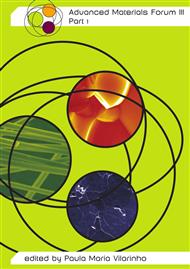p.666
p.672
p.677
p.682
p.687
p.692
p.697
p.702
p.707
The Influence of the Addition of Ti on the Mechanical Properties of W-S-Ti Coatings
Abstract:
In this work, W-S-Ti films were deposited by r.f. magnetron sputtering, using simultaneously WS2 and Ti targets. The atomic percentage of Ti in the coating was varied from 0 at.% up to 28 at.%. No significant variations in the S/W ratio with the increase of Ti content were observed. The increasing Ti contents in the films led to a gradual loss of crystallinity. Coatings with contents greater than ≈ 16 at.% only presents a broad peak characteristic of amorphous structures. Alloying the films with Ti led to significant improvements in the hardness (from 0.3 to 8.9 GPa). Also, the adhesive critical load continuously grew with the increase of the Ti content in the films. The wear coefficient of the films dropped more than one order of magnitude with the increase of Ti content whereas the friction coefficient was kept fairly constant with just a small increase in relation to single W-S film. In conclusion, to have a good tribological performance, the addition of Ti to the films should be balanced in order that the increase of the mechanical properties does not lead to severe loss of the self-lubricant properties.
Info:
Periodical:
Pages:
687-691
Citation:
Online since:
May 2006
Authors:
Keywords:
Price:
Сopyright:
© 2006 Trans Tech Publications Ltd. All Rights Reserved
Share:
Citation:


